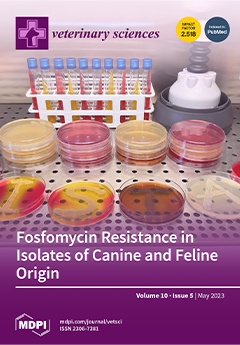Serum bicarbonate deficiency is a disorder frequently found in human patients with acute (AKI) and chronic (CKD) kidney disease, due to abnormalities in kidney generation and reabsorption of bicarbonate. Although alkali supplementation is usually performed in both humans and veterinary CKD patients, data
[...] Read more.
Serum bicarbonate deficiency is a disorder frequently found in human patients with acute (AKI) and chronic (CKD) kidney disease, due to abnormalities in kidney generation and reabsorption of bicarbonate. Although alkali supplementation is usually performed in both humans and veterinary CKD patients, data regarding the frequency of bicarbonate disorders in AKI and CKD dogs are scarce. The aim of the present study is to assess the frequency and the severity of bicarbonate deficiency of dogs affected by AKI, acute chronic kidney disease (ACKD), and CKD, and to investigate its possible association with the IRIS grade/stage as well as with disorders of calcium phosphate metabolism. A retrospective evaluation of the serum biochemical panels of all dogs with diagnoses of AKI, ACKD, and CKD referred to the nephrology and urology service of the Veterinary Teaching Hospital of the University of Pisa, between January 2014 and January 2022, was performed. Bicarbonate deficiency was defined as serum bicarbonate < 22 mmol/L and classified as moderate (between 18 and 22 mmol/L) or severe (<18 mmol/L). Serum bicarbonate deficiency was found in 397/521 dogs (76%), of which 142/397 (36%) showed moderate deficiency, and 255/397 (64%) severe deficiency. Dogs with AKI and ACKD showed a significantly higher frequency of bicarbonate deficiency (
p = 0.004) and severe forms compared to CKD dogs (
p = 0.02). In AKI and ACKD dogs, a negative linear correlation was found between serum bicarbonate and serum creatinine, urea, and phosphate. The frequency of bicarbonate deficiency was higher in the later stages of the disease in both AKI (
p = 0.01), ACKD (
p = 0.0003), and CKD dogs (
p = 0.009). Dogs with serum CaxP ≥ 70 mg
2/dL
2 showed a higher frequency of bicarbonate deficiency (
p = 0.01) and showed severe forms (
p = 0.01) compared to dogs with CaxP < 70 mg
2/dL
2. Serum bicarbonate deficiency seems to be a very frequent disorder in both AKI, ACKD, and CKD dogs, with an increasing frequency and severity in more advanced stages of kidney disease. The higher frequency and severity of bicarbonate deficiency in AKI and ACKD may be caused by a more severe and sudden loss of kidney function, or extra-renal factors. Finally, the association between frequency and severity of bicarbonate deficiency and abnormal CaxP may suggest a potential connection between metabolic acidosis and bone mineral disorders.
Full article






